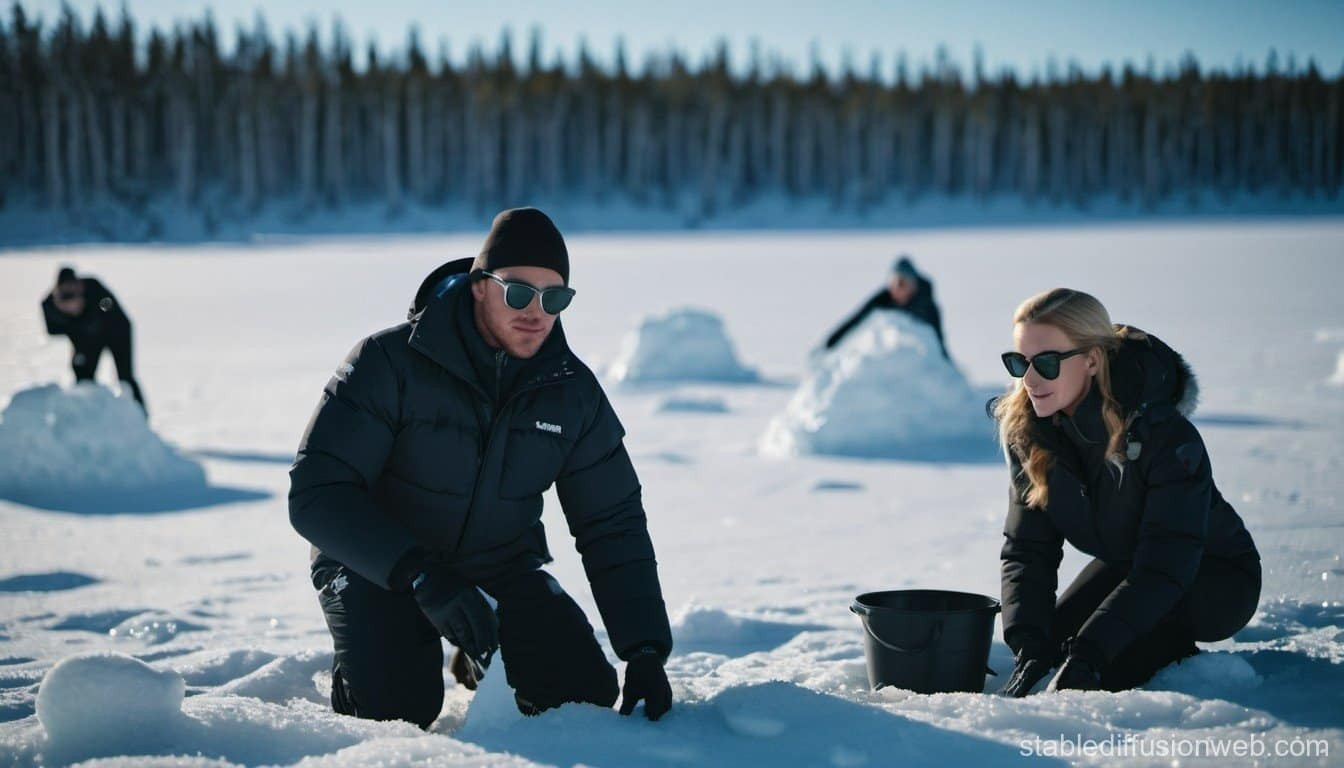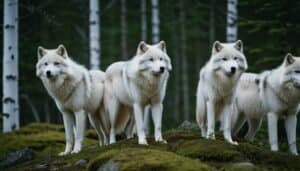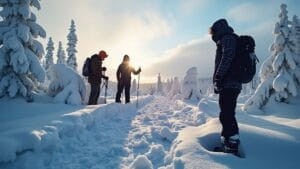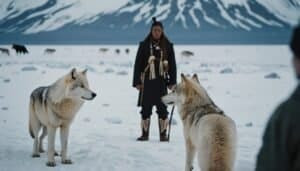Introduction
The conservation of Arctic wolves is a critical issue that requires the involvement of local communities. This article explores the main threats to Arctic wolves and outlines various ways communities can contribute to their conservation
From educational programs and habitat restoration to community monitoring and policy support, we will discuss effective strategies and provide examples of successful community-led initiatives
Additionally, we will highlight the role of citizen science, resources available for conservation efforts, and ways to raise awareness about the importance of protecting these majestic animals
Main Threats to Arctic Wolves
Arctic wolves face numerous threats that endanger their populations and habitats. Understanding these threats is crucial for devising effective conservation strategies. This section explores the primary challenges Arctic wolves encounter, including predation and competition, climate change, and human activities
Predation and Competition
Predation and competition are natural ecological processes, but they can significantly impact Arctic wolf populations
Predation primarily involves natural predators such as bears and other larger carnivores. However, competition with other predators like red foxes, which are expanding their range due to climate change, poses a significant threat. These competitors can encroach on Arctic wolves’ territories, reducing their access to food and resources
Arctic wolves primarily feed on muskoxen, Arctic hares, and caribou. The presence of other predators can lead to a decrease in available prey, forcing Arctic wolves to travel longer distances in search of food
This increased competition can lead to higher mortality rates, particularly among younger and weaker wolves, affecting the overall population dynamics
Climate Change
Climate change is one of the most significant threats to Arctic wolves. Rising temperatures and melting ice are transforming the Arctic landscape, affecting the availability of prey and suitable habitat. As the ice melts, the tundra ecosystem, which Arctic wolves depend on, is shrinking. This habitat loss forces wolves to adapt to new environments or face population declines
Moreover, climate change disrupts the migration patterns of prey species like caribou, making it harder for Arctic wolves to hunt and sustain their packs
The changing climate also introduces new diseases and parasites to the Arctic region, which can further threaten wolf populations. These environmental changes are rapid, leaving little time for Arctic wolves to adapt, leading to potential long-term declines in their numbers
Human Activities
Human activities, including industrial development, hunting, and pollution, pose direct and indirect threats to Arctic wolves. Industrial activities such as mining and oil drilling disrupt the natural habitats of Arctic wolves, leading to habitat fragmentation and increased human-wolf encounters
These encounters can result in wolves being killed or displaced from their territories
Hunting, both legal and illegal, also contributes to the decline of Arctic wolf populations. While hunting of Arctic wolves is regulated in some areas, poaching remains a significant problem
Additionally, human activities often lead to pollution, which can contaminate the food and water sources of Arctic wolves, further endangering their survival
Efforts to mitigate these threats involve implementing strict regulations on industrial activities, enforcing anti-poaching laws, and promoting sustainable practices that minimize environmental impact. Engaging local communities in these conservation efforts is vital to ensure the long-term survival of Arctic wolves
Community Conservation Efforts
Local communities play a crucial role in the conservation of Arctic wolves. Through various initiatives, communities can help protect these animals and their habitats
This section examines educational programs, habitat restoration efforts, and community monitoring programs as effective ways for communities to contribute to Arctic wolf conservation
Educational Programs
Educational programs are fundamental in raising awareness and fostering a sense of responsibility towards Arctic wolf conservation. These programs can be implemented in schools, community workshops, and through online resources, targeting different segments of the community
School Programs
Integrating Arctic wolf conservation into school curricula helps educate young students about the importance of wildlife and environmental stewardship
Schools can organize field trips to natural habitats, invite experts to give talks, and engage students in projects related to Arctic wolf conservation. By instilling a sense of responsibility from a young age, schools can cultivate future conservation advocates
Community Workshops
Community workshops provide a platform for residents to learn about Arctic wolves and the threats they face
These workshops can cover topics such as the biology of Arctic wolves, their role in the ecosystem, and ways to mitigate human-wolf conflicts. Workshops can also include practical training on monitoring techniques and habitat restoration activities, encouraging community members to take an active role in conservation efforts
Online Resources
The internet is a powerful tool for spreading information about Arctic wolf conservation. Creating and sharing educational content through websites, social media, and online courses can reach a wider audience
These resources can include videos, articles, and interactive modules that educate people about Arctic wolves and how they can contribute to their conservation
Habitat Restoration
Restoring and protecting habitats is vital for the survival of Arctic wolves. Communities can engage in various activities to restore natural habitats, ensuring that these animals have the necessary resources to thrive
Reforestation
Reforestation efforts help restore areas that have been deforested or degraded due to human activities
Planting native trees and vegetation can create suitable habitats for prey species, which in turn supports the food chain for Arctic wolves. Community-driven reforestation projects can involve local volunteers and schools, fostering a collective effort towards environmental restoration
Pollution Cleanup
Pollution, including plastic waste and chemical contaminants, can severely impact the Arctic ecosystem
Community-led cleanup campaigns can help remove pollutants from natural habitats, ensuring cleaner and safer environments for Arctic wolves and other wildlife. Organizing regular cleanup events and educating the public about proper waste disposal can significantly reduce pollution levels
Protecting Prey Species
Conserving the prey species of Arctic wolves is essential for their survival
Communities can engage in activities that protect these species, such as creating wildlife corridors, protecting breeding grounds, and reducing human-wildlife conflicts. Ensuring a stable prey population helps maintain the balance of the ecosystem, supporting the dietary needs of Arctic wolves
Monitoring Programs
Community monitoring programs enable residents to actively participate in tracking and protecting Arctic wolf populations. These programs involve various activities that contribute to the conservation of these animals
Tracking and Observation
Training community members to track and observe Arctic wolves can provide valuable data for conservation efforts
Residents can learn to identify wolf tracks, observe behavior, and record sightings. This information helps researchers understand wolf populations and their movements, informing conservation strategies
Reporting Sightings
Encouraging community members to report wolf sightings can help create a comprehensive database of Arctic wolf activity
This data can be used to monitor population trends, identify critical habitats, and detect potential threats. Reporting sightings through apps or community websites makes it easier for residents to contribute to conservation efforts
Data Collection
Collecting data on Arctic wolf populations, prey availability, and environmental conditions is crucial for effective conservation. Community members can be trained to gather and report data, contributing to research projects and conservation plans
This collaborative approach ensures that local knowledge and observations are integrated into broader conservation strategies
Successful Community-Led Conservation Examples
Community-led conservation efforts have shown significant success in protecting Arctic wolves
By examining case studies, we can understand the effective strategies and collaborative approaches that have led to positive outcomes. This section highlights three successful examples of community-led conservation initiatives
Case Study 1: Nunavut Community Wolf Project
In Nunavut, Canada, local communities have implemented a comprehensive conservation project aimed at protecting Arctic wolves. This initiative involves traditional ecological knowledge, modern scientific techniques, and community engagement
The project includes regular monitoring of wolf populations using both GPS collars and community reporting systems. Local hunters and elders contribute their knowledge of wolf behavior and habitats, which is integrated with scientific data to create effective conservation plans. Educational programs in schools and community centers raise awareness about the importance of Arctic wolves and the threats they face
This collaborative approach has led to a better understanding of wolf populations and successful mitigation of human-wolf conflicts. The community’s active involvement ensures that conservation efforts are culturally appropriate and sustainable
Case Study 2: Greenland Wolf Conservation Initiative
Greenland has seen notable success in Arctic wolf conservation through a community-driven initiative that focuses on habitat protection and education. The Greenland Wolf Conservation Initiative involves local residents, government agencies, and international conservation organizations
Key activities include habitat restoration projects, such as reforestation and pollution cleanup, to improve the living conditions for Arctic wolves. The initiative also promotes eco-tourism, providing economic benefits to the community while raising awareness about wolf conservation
Educational workshops and outreach programs have been implemented to inform residents and visitors about the importance of Arctic wolves. The initiative also includes citizen science programs where locals are trained to monitor wolf populations and report sightings, contributing valuable data for research and conservation efforts
Case Study 3: Alaska Community Conservation Network
In Alaska, the Community Conservation Network has successfully engaged local communities in protecting Arctic wolves through various grassroots efforts. This network connects multiple communities, fostering collaboration and knowledge sharing
One of the key components of this initiative is community-based research, where residents are trained to conduct wildlife surveys and collect ecological data. This hands-on involvement empowers communities to take ownership of conservation efforts and ensures that local insights are integrated into conservation strategies
The network also organizes annual conservation festivals, bringing together community members, researchers, and policymakers to discuss conservation challenges and solutions. These events help build a strong conservation culture and encourage ongoing community involvement
Supporting Conservation Through Local Policies
Local policies play a crucial role in supporting Arctic wolf conservation efforts. By implementing and enforcing effective policies, communities can create a supportive environment for conservation activities. This section explores how legislation, funding and grants, and partnerships with organizations can enhance local conservation efforts
Legislation
Enacting and enforcing laws that protect Arctic wolves and their habitats is essential for conservation success
Local governments can implement policies that restrict industrial activities in critical habitats, regulate hunting, and prevent habitat destruction. Strong legal frameworks provide the foundation for effective conservation efforts and ensure that violators are held accountable
Funding and Grants
Securing funding and grants is vital for supporting conservation projects. Local governments, non-profit organizations, and community groups can apply for grants from national and international conservation funds
These financial resources can be used for habitat restoration, educational programs, monitoring efforts, and other conservation activities. Transparent and efficient use of funds ensures that resources are maximized for conservation impact
Partnerships with Organizations
Collaborating with conservation organizations, research institutions, and other stakeholders can enhance the effectiveness of local conservation efforts
Partnerships provide access to expertise, resources, and support that can amplify community-driven initiatives. Working together with organizations that have a shared goal of Arctic wolf conservation fosters a collaborative approach and increases the chances of success
Resources for Community Conservation Efforts
Various resources are available to support community efforts in Arctic wolf conservation. These resources include government programs, non-profit organizations, and volunteer opportunities that provide the necessary tools and support for effective conservation
Government Programs
Government programs at local, state, and federal levels often provide funding, training, and resources for conservation projects
These programs can support habitat restoration, wildlife monitoring, and educational initiatives. Engaging with government agencies can help communities access these resources and ensure that their conservation efforts are aligned with broader environmental policies
Non-Profit Organizations
Non-profit organizations dedicated to wildlife conservation offer valuable support to local communities
These organizations can provide funding, technical expertise, educational materials, and advocacy support. Collaborating with non-profits can help communities implement effective conservation strategies and raise awareness about Arctic wolf conservation
Volunteer Opportunities
Volunteering is a powerful way for community members to contribute to conservation efforts. Local conservation projects often rely on volunteers for activities such as habitat restoration, data collection, and public outreach
Providing opportunities for community members to get involved fosters a sense of ownership and responsibility towards conservation efforts
The Role of Citizen Science
Citizen science initiatives involve the public in scientific research and data collection, playing a significant role in Arctic wolf conservation. By engaging local communities in research projects, data sharing platforms, and providing training and support, citizen science can enhance conservation efforts.
Community Research Projects
Community-led research projects empower residents to contribute to scientific knowledge about Arctic wolves
These projects can involve tracking wolf populations, monitoring prey species, and studying environmental changes. The data collected by community members can provide valuable insights for researchers and inform conservation strategies
Data Sharing Platforms
Data sharing platforms allow communities to report their observations and findings, creating a comprehensive database of information about Arctic wolves
These platforms facilitate collaboration between community members, researchers, and conservation organizations. Access to shared data enhances the understanding of wolf populations and supports evidence-based conservation efforts
Training and Support
Providing training and support to community members ensures that they have the necessary skills and knowledge to participate in conservation activities
Workshops, online courses, and hands-on training can equip residents with the tools needed for effective data collection and monitoring. Continuous support helps maintain community engagement and ensures the sustainability of citizen science initiatives
Climate Change and Arctic Wolves
Climate change poses a significant threat to Arctic wolves, impacting their habitat and survival. Communities can play a vital role in addressing these challenges through adaptation strategies and action plans
Impact on Habitat
Climate change alters the Arctic landscape, affecting the availability of prey and suitable habitats for Arctic wolves. Melting ice and changing vegetation patterns force wolves to adapt to new conditions or migrate to new areas. Understanding these impacts is crucial for developing effective conservation strategies
Adaptation Strategies
Communities can implement adaptation strategies to help Arctic wolves cope with the effects of climate change
These strategies can include protecting critical habitats, enhancing habitat connectivity, and ensuring the availability of prey species. By proactively addressing climate change impacts, communities can support the long-term survival of Arctic wolves
Community Action Plans
Developing and implementing community action plans for climate change mitigation and adaptation is essential for Arctic wolf conservation
These plans can involve reducing greenhouse gas emissions, promoting sustainable practices, and engaging in habitat restoration projects. Community involvement in climate action ensures that conservation efforts are comprehensive and locally relevant
Raising Awareness in Local Communities
Raising awareness about the importance of Arctic wolves and the threats they face is crucial for garnering community support for conservation efforts. Effective strategies include media campaigns, community events, and educational materials
Media Campaigns
Media campaigns can reach a broad audience, spreading information about Arctic wolf conservation and encouraging public support
Utilizing social media, local newspapers, radio, and television can help raise awareness about the importance of protecting Arctic wolves. Engaging storytelling and visual content can capture the public’s interest and inspire action
Community Events
Organizing community events such as wildlife festivals, conservation workshops, and educational talks can foster a sense of community involvement in conservation efforts. These events provide opportunities for residents to learn about Arctic wolves, participate in conservation activities, and connect with like-minded individuals
Educational Materials
Creating and distributing educational materials such as brochures, posters, and online content can help inform the public about Arctic wolf conservation
These materials can be used in schools, community centers, and public spaces to raise awareness and provide information on how individuals can contribute to conservation efforts
Conclusion
Community involvement is essential for the conservation of Arctic wolves. Local communities can make a significant impact through various efforts such as educational programs, habitat restoration, monitoring, and policy support
By examining successful community-led conservation examples, we can see the effectiveness of collaborative approaches. Resources from government programs, non-profit organizations, and volunteer opportunities provide the necessary support for these initiatives. Citizen science further enhances conservation efforts by involving residents in research and data collection
Additionally, addressing climate change and raising awareness about Arctic wolves are crucial steps that communities can take to ensure the survival of these majestic animals. Together, through dedicated and informed efforts, local communities can play a vital role in preserving the Arctic wolves for future generations










